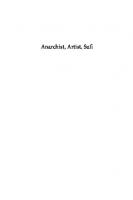Titian & tragic painting : Aristotle's Poetics and the rise of the modern artist 9780300110005, 0300110006
Late in his life Titian created a series of paintings—the “Four Sinners,” the “poesie” for his patron Philip II of Spain
269 89 53MB
English Pages 239 [254] Year 2005
COVER
CONTENTS
ACKNOWLEDGEMENTS
INTRODUCTION
PART I: ON THE STATUS OF PAINTING IN THE RENAISSANCE
1 Painting, Poetry and the Liberal Arts
PAINTING AND THE LIBERAL ARTS
ARTISTS AT COURT
UT PICTURA POESIS
ALBERTI
LEONARDO
FLORENCE AND VENICE CIRCA 1550
2 Imitation, Moral Purpose and Learning
PLATO'S 'REPUBLIC' AND THE CONDEMNATION OF THE IMITATIVE ARTS
THE RENAISSANCE DEFENCE OF POETRY
(a) The 'utile'
(b) The 'idea'
SPERONE SPERONI’S DIALOGO D’AMORE
ART THEORY CIRCA 1550 AND IMITATION
ARISTOTLE ON IMITATION
3 Tragedy
COMIC AND TRAGIC DRAMA
NARRATIVE AND DRAMATIC POETRY
TRAGEDY AND THE PLOT
THE EMOTIVE MEANS OF TRAGEDY: DISCOVERY, PERIPETY AND SUFFERING
THE EMOTIONAL EFFECTS OF TRAGEDY: PITY, FEAR AND AWE OR MARVEL
SIXTEENTH-CENTURY DEBATES AROUND ARISTOTLE’S POETICS
TRAGEDY AND PAINTING IN VENICE
PART II: TITIAN AND TRAGEDY
4 The Four Great Sinners
THE MATERIAL AND CRITICAL HISTORY OF THE CYCLE
THE FESTIVITIES AT BINCHE
THE FOUR SINNERS AS FIGURES OF TRAGEDY
DENORES ON INFERNAL TRAGEDIES
TITIAN’S CYCLE AS A PAINTED TRAGEDY
5 Michelangelo and Titian: Terribilità and Tragic Pathos
TITIAN IN ROME
THE AFFETTI
TERRIBILITA
PATHOS IN RHETORIC AND DRAMA AND TITIAN’S ART AFTER ROME
6 Titian's Mythological Paintings: Problems of Interpretation
THE PAINTINGS FOR ALFONSO’S CAMERINO
SOME PROBLEMS OF INTERPRETATION: VIEWING ICONOLOGICALLY OR POETICALLY
CORREGGIO'S 'LOVES OF JUPITER'
THE POESIE FOR PHILIP III A DIFFERENCE OF AGE?
VIEWING MORALLY AND ALLEGORICALLY
PATRON AND PAINTER
EROTIC VIEWING
AESTHETIC VIEWING
DRAMATIC VIEWING
7 Titian's poesie for Philip II as Painted Tragedies
MARAVIGLIA
DANAE
VENUS AND ADONIS
PERSEUS AND ANDROMEDA
JASON AND MEDEA
THE RAPE OF EUROPA
DIANA AND ACTAEON AND DIANA AND CALLISTO
THE DEATH OF ACTAEON
EROTICISM AND TRAGIC RESPONSE
8 The Final Tragedies and Titian's 'Late Style'
THE LAST ALTARPIECES
THE LAST MYTHOLOGIES
FINISH
NOTES
INTRODUCTION
CHAPTER 1
CHAPTER 2
CHAPTER 3
CHAPTER 4
CHAPTER 5
CHAPTER 6
CHAPTER 7
CHAPTER 8
BIBLIOGRAPHY
INDEX
Photograph credits
Recommend Papers

- Author / Uploaded
- Thomas Puttfarken
File loading please wait...
Citation preview
PHILLIPS ACAO
3 1867 00507 6455
Titian and Tragic Painiing
Thomas' Puttfarken
I*
TITIAN
AND TRAGIC •
PAINTING Painting Aristotle’s Poetics and the Rise of the Modern Artist * C- > ” ■
·*
Thomas Puttfarken
Late in his life Titian created a series of paintings - the ‘Four Sinners’, the ‘poesie’ for his patron Philip n of Spain, and the ‘Final Tragedies’ - that were dark in tone and content, full of pathos and physical suffering.
In this major reinterpretation ofTitian’s art, Thomas Puttfarken shows that the often dramatic and violent subject matter of these works was not, as is often argued, the consequence of the artist’s increasing .uB and sense of isolation and tragedy. Rather, these paintings were influenced by discussions of Aristotle’s Poetics that permeated learned discourse in Italy in the mid-sixteenth century. The Poetics led directly to a rich theory of the visual arts, and painting in particular, that enabled artists like Titian to consider themselves on equal footing with poets. Puttfarken- investigates Titian’s late works in this context and analyses his relations with his patrons, his intellectual and humanistic contacts and his choices of subject matter, style and technique. a
·.·“ .
'
.









